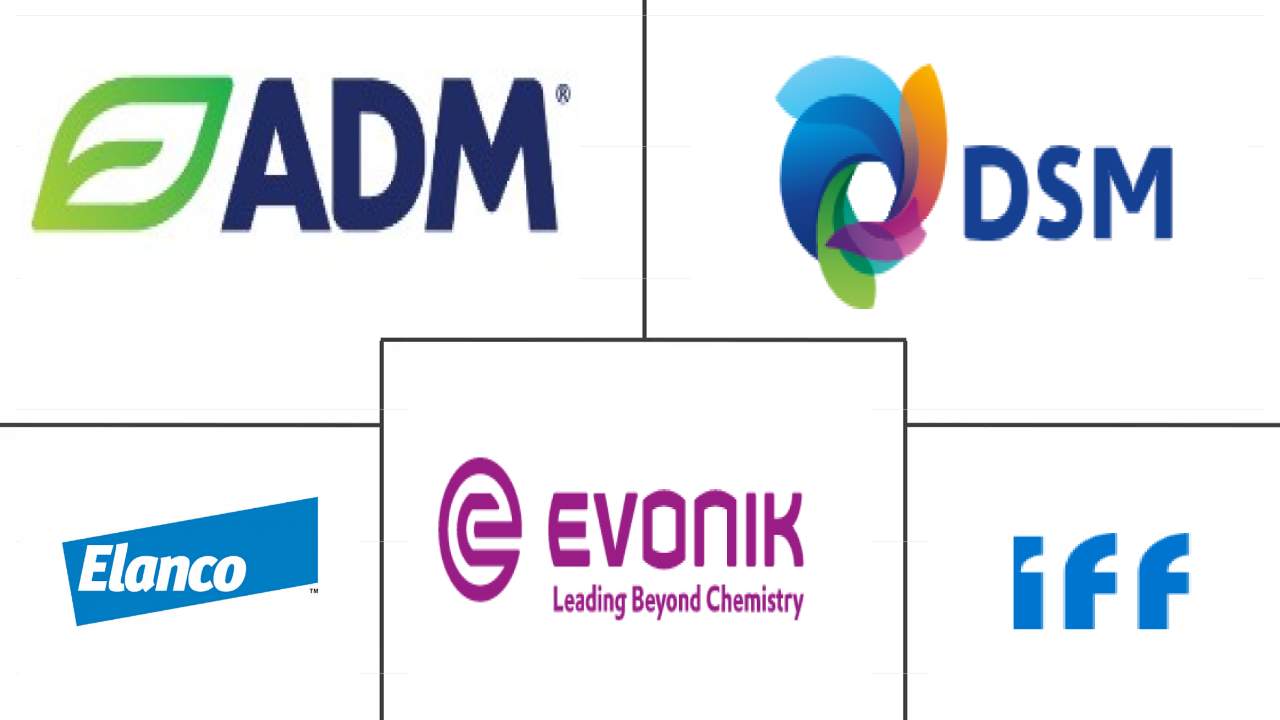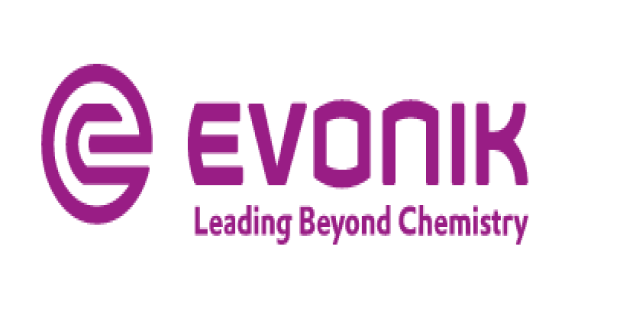Market Size of canada feed additives Industry
|
|
Study Period | 2017 - 2029 |
|
|
Market Size (2024) | USD 0.97 Billion |
|
|
Market Size (2029) | USD 1.20 Billion |
|
|
Largest Share by Additive | Amino Acids |
|
|
CAGR (2024 - 2029) | 4.40 % |
|
|
Fastest Growing by Additive | Acidifiers |
Major Players |
||

|
||
|
*Disclaimer: Major Players sorted in no particular order |
Canada Feed Additives Market Analysis
The Canada Feed Additives Market size is estimated at 0.97 billion USD in 2024, and is expected to reach 1.20 billion USD by 2029, growing at a CAGR of 4.40% during the forecast period (2024-2029).
0.97 Billion
Market Size in 2024 (USD)
1.20 Billion
Market Size in 2029 (USD)
5.11 %
CAGR (2017-2023)
4.40 %
CAGR (2024-2029)
Largest Market by Additive
17.56 %
value share, Amino Acids, 2023
Amino acids comprise the largest segment due to their benefits, such as improved gut health, better muscle development, and high protein, and an increase in the animal population in the country.
Largest Market by Animal
37.76 %
value share, Swine, 2023
Swine comprises the largest animal segment in the market, owing to the demand for pork meat, which has helped in the growth of swine feed that helps in developing a strong immune system.
Fastest-growing Market by Additive
6.26 %
Projected CAGR, Acidifiers, 2024-2029
Acidifiers comprise the fastest-growing segment owing to the rising demand for meat, milk, and milk products and rising awareness about the benefits of feed acidifiers.
Fastest-growing Market by Animal
4.71 %
Projected CAGR, Poultry, 2024-2029
Poultry is the fastest-growing segment due to the rising demand for poultry meat, the increase in commercial egg production, and the increasing population of poultry birds.
Leading Market Player
13.23 %
market share, Evonik Industries AG, 2022

It is the market leader as the company has a partnership with Halchemix Canada to promote the sales of its feed amino acids. The company has five production facilities in the country.
- The Canadian feed additives market has grown steadily in recent years, and in 2022, it accounted for 10.4% of the North American feed additives market, with a value of almost USD 0.9 billion. Amino acids were the largest segment in the market in 2022, which occupied almost USD 0.16 billion in terms of value, with lysine being the most popular amino acid, valued at USD 67 million. The popularity of lysine was due to its lower cost, which resulted in reduced veterinary costs for animal farmers.
- Swine was the largest animal type in the Canadian feed additives market, with a share of 37.7% in 2022, followed by ruminants and poultry birds, which accounted for 29.5% and 25.5% of the market, respectively. Dairy cattle and broilers were the largest sub-segments, accounting for 21% and 14.7% of the market, respectively. The high dosage rate and feed production with respect to swine in Canada contributed to its dominance in the market.
- The fastest-growing feed additive type in Canada is expected to be feed acidifiers, with a CAGR of 6.2% during the forecast period. This growth rate may be attributed to their ability to improve growth by increasing the feed conversion ratio, as well as providing resistance to harmful pathogens, such as bacteria, and reducing the dependence on antibiotics. Using feed acidifiers has also been found to enhance animal welfare and reduce environmental impacts.
- The demand for meat and meat products is expected to increase in Canada. It is expected to drive the growth of the Canadian feed additives market while recording a CAGR of 4.4% during the forecast period. The increase in commercial livestock cultivation for the dairy industry is also expected to contribute to the market's growth.
Canada Feed Additives Industry Segmentation
Acidifiers, Amino Acids, Antibiotics, Antioxidants, Binders, Enzymes, Flavors & Sweeteners, Minerals, Mycotoxin Detoxifiers, Phytogenics, Pigments, Prebiotics, Probiotics, Vitamins, Yeast are covered as segments by Additive. Aquaculture, Poultry, Ruminants, Swine are covered as segments by Animal.
- The Canadian feed additives market has grown steadily in recent years, and in 2022, it accounted for 10.4% of the North American feed additives market, with a value of almost USD 0.9 billion. Amino acids were the largest segment in the market in 2022, which occupied almost USD 0.16 billion in terms of value, with lysine being the most popular amino acid, valued at USD 67 million. The popularity of lysine was due to its lower cost, which resulted in reduced veterinary costs for animal farmers.
- Swine was the largest animal type in the Canadian feed additives market, with a share of 37.7% in 2022, followed by ruminants and poultry birds, which accounted for 29.5% and 25.5% of the market, respectively. Dairy cattle and broilers were the largest sub-segments, accounting for 21% and 14.7% of the market, respectively. The high dosage rate and feed production with respect to swine in Canada contributed to its dominance in the market.
- The fastest-growing feed additive type in Canada is expected to be feed acidifiers, with a CAGR of 6.2% during the forecast period. This growth rate may be attributed to their ability to improve growth by increasing the feed conversion ratio, as well as providing resistance to harmful pathogens, such as bacteria, and reducing the dependence on antibiotics. Using feed acidifiers has also been found to enhance animal welfare and reduce environmental impacts.
- The demand for meat and meat products is expected to increase in Canada. It is expected to drive the growth of the Canadian feed additives market while recording a CAGR of 4.4% during the forecast period. The increase in commercial livestock cultivation for the dairy industry is also expected to contribute to the market's growth.
| Additive | |||||||||||
| |||||||||||
| |||||||||||
| |||||||||||
| |||||||||||
| |||||||||||
| |||||||||||
| |||||||||||
| |||||||||||
| |||||||||||
| |||||||||||
| |||||||||||
| |||||||||||
| |||||||||||
| |||||||||||
|
| Animal | |||||||
| |||||||
| |||||||
| |||||||
| Swine | |||||||
| Other Animals |
Canada Feed Additives Market Size Summary
The Canadian feed additives market has experienced steady growth, contributing significantly to the North American market. Amino acids, particularly lysine, have been prominent due to their cost-effectiveness, which helps reduce veterinary expenses for animal farmers. Swine dominate the market, driven by high dosage rates and substantial feed production, followed by ruminants and poultry. Feed acidifiers are anticipated to be the fastest-growing segment, attributed to their benefits in enhancing feed conversion ratios, improving animal welfare, and reducing environmental impacts. The increasing demand for meat and meat products, alongside the expansion of commercial livestock for the dairy industry, is expected to further propel market growth.
The poultry industry in Canada has shown consistent growth, with rising production of poultry meat and eggs, supported by government investments and increased producer numbers. The aquaculture sector is also expanding, driven by the growing demand for seafood and the recovery from pandemic-related disruptions. Salmon remains a key species due to its high demand and availability. The market is moderately consolidated, with major players like Archer Daniel Midland Co., DSM Nutritional Products AG, and Elanco Animal Health Inc. leading the industry. Strategic partnerships and innovations, such as those between Evonik and BASF, and Elanco and Royal DSM, are enhancing the market's capabilities and global presence.
Canada Feed Additives Market Size - Table of Contents
-
1. MARKET SEGMENTATION (includes market size in Value in USD and Volume, Forecasts up to 2029 and analysis of growth prospects)
-
1.1 Additive
-
1.1.1 Acidifiers
-
1.1.1.1 By Sub Additive
-
1.1.1.1.1 Fumaric Acid
-
1.1.1.1.2 Lactic Acid
-
1.1.1.1.3 Propionic Acid
-
1.1.1.1.4 Other Acidifiers
-
-
-
1.1.2 Amino Acids
-
1.1.2.1 By Sub Additive
-
1.1.2.1.1 Lysine
-
1.1.2.1.2 Methionine
-
1.1.2.1.3 Threonine
-
1.1.2.1.4 Tryptophan
-
1.1.2.1.5 Other Amino Acids
-
-
-
1.1.3 Antibiotics
-
1.1.3.1 By Sub Additive
-
1.1.3.1.1 Bacitracin
-
1.1.3.1.2 Penicillins
-
1.1.3.1.3 Tetracyclines
-
1.1.3.1.4 Tylosin
-
1.1.3.1.5 Other Antibiotics
-
-
-
1.1.4 Antioxidants
-
1.1.4.1 By Sub Additive
-
1.1.4.1.1 Butylated Hydroxyanisole (BHA)
-
1.1.4.1.2 Butylated Hydroxytoluene (BHT)
-
1.1.4.1.3 Citric Acid
-
1.1.4.1.4 Ethoxyquin
-
1.1.4.1.5 Propyl Gallate
-
1.1.4.1.6 Tocopherols
-
1.1.4.1.7 Other Antioxidants
-
-
-
1.1.5 Binders
-
1.1.5.1 By Sub Additive
-
1.1.5.1.1 Natural Binders
-
1.1.5.1.2 Synthetic Binders
-
-
-
1.1.6 Enzymes
-
1.1.6.1 By Sub Additive
-
1.1.6.1.1 Carbohydrases
-
1.1.6.1.2 Phytases
-
1.1.6.1.3 Other Enzymes
-
-
-
1.1.7 Flavors & Sweeteners
-
1.1.7.1 By Sub Additive
-
1.1.7.1.1 Flavors
-
1.1.7.1.2 Sweeteners
-
-
-
1.1.8 Minerals
-
1.1.8.1 By Sub Additive
-
1.1.8.1.1 Macrominerals
-
1.1.8.1.2 Microminerals
-
-
-
1.1.9 Mycotoxin Detoxifiers
-
1.1.9.1 By Sub Additive
-
1.1.9.1.1 Binders
-
1.1.9.1.2 Biotransformers
-
-
-
1.1.10 Phytogenics
-
1.1.10.1 By Sub Additive
-
1.1.10.1.1 Essential Oil
-
1.1.10.1.2 Herbs & Spices
-
1.1.10.1.3 Other Phytogenics
-
-
-
1.1.11 Pigments
-
1.1.11.1 By Sub Additive
-
1.1.11.1.1 Carotenoids
-
1.1.11.1.2 Curcumin & Spirulina
-
-
-
1.1.12 Prebiotics
-
1.1.12.1 By Sub Additive
-
1.1.12.1.1 Fructo Oligosaccharides
-
1.1.12.1.2 Galacto Oligosaccharides
-
1.1.12.1.3 Inulin
-
1.1.12.1.4 Lactulose
-
1.1.12.1.5 Mannan Oligosaccharides
-
1.1.12.1.6 Xylo Oligosaccharides
-
1.1.12.1.7 Other Prebiotics
-
-
-
1.1.13 Probiotics
-
1.1.13.1 By Sub Additive
-
1.1.13.1.1 Bifidobacteria
-
1.1.13.1.2 Enterococcus
-
1.1.13.1.3 Lactobacilli
-
1.1.13.1.4 Pediococcus
-
1.1.13.1.5 Streptococcus
-
1.1.13.1.6 Other Probiotics
-
-
-
1.1.14 Vitamins
-
1.1.14.1 By Sub Additive
-
1.1.14.1.1 Vitamin A
-
1.1.14.1.2 Vitamin B
-
1.1.14.1.3 Vitamin C
-
1.1.14.1.4 Vitamin E
-
1.1.14.1.5 Other Vitamins
-
-
-
1.1.15 Yeast
-
1.1.15.1 By Sub Additive
-
1.1.15.1.1 Live Yeast
-
1.1.15.1.2 Selenium Yeast
-
1.1.15.1.3 Spent Yeast
-
1.1.15.1.4 Torula Dried Yeast
-
1.1.15.1.5 Whey Yeast
-
1.1.15.1.6 Yeast Derivatives
-
-
-
-
1.2 Animal
-
1.2.1 Aquaculture
-
1.2.1.1 By Sub Animal
-
1.2.1.1.1 Fish
-
1.2.1.1.2 Shrimp
-
1.2.1.1.3 Other Aquaculture Species
-
-
-
1.2.2 Poultry
-
1.2.2.1 By Sub Animal
-
1.2.2.1.1 Broiler
-
1.2.2.1.2 Layer
-
1.2.2.1.3 Other Poultry Birds
-
-
-
1.2.3 Ruminants
-
1.2.3.1 By Sub Animal
-
1.2.3.1.1 Beef Cattle
-
1.2.3.1.2 Dairy Cattle
-
1.2.3.1.3 Other Ruminants
-
-
-
1.2.4 Swine
-
1.2.5 Other Animals
-
-
Canada Feed Additives Market Size FAQs
How big is the Canada Feed Additives Market?
The Canada Feed Additives Market size is expected to reach USD 966.64 million in 2024 and grow at a CAGR of 4.40% to reach USD 1.20 billion by 2029.
What is the current Canada Feed Additives Market size?
In 2024, the Canada Feed Additives Market size is expected to reach USD 966.64 million.

